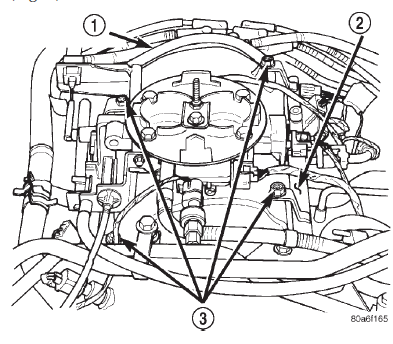Fuel rail-3.9/5.2/5.9L engines. Fuel injector rail-4.7L engine
DESCRIPTION The fuel injector rail is used to attach the fuel
injectors to the engine. It is mounted to the engine
(Fig. 5).
1 - FUEL RAIL CONNECTING HOSE 2 - FUEL RAIL 3 - MOUNTING BOLTS (4) OPERATION High pressure from the fuel pump is routed to the
fuel rail. The fuel rail then supplies the necessary
fuel to each individual fuel injector.
A fuel pressure test port is located on the fuel rail.
A quick-connect fitting with a safety latch clip is
used to attach the fuel line to the fuel rail.
The fuel rail is not repairable. CAUTION: The left and right sections of the fuel rail
are connected with a flexible connecting hose. Do
not attempt to separate the rail halves at this connecting
hose. Due to the design of this connecting
hose, it does not use any clamps. Never attempt to
install a clamping device of any kind to the hose.
When removing the fuel rail assembly for any reason,
be careful not to bend or kink the connecting
hose. DESCRIPTION The fuel injector rail is used to mount the fuel
injectors to the engine. It is mounted to the intake
manifold (Fig. 6). OPERATION High pressure fuel from the fuel pump is routed to
the fuel rail. The fuel rail then supplies the necessary
fuel to each individual fuel injector.
A fuel pressure test port is located on the fuel rail
(Fig. 6). A quick-connect fitting with a safety latch is
used to attach the fuel line to the fuel rail.
The fuel rail is not repairable. CAUTION: 4.7L Engine Only: The left and right sections
of the fuel rail are joined with a connector
tube (Fig. 6). Do not attempt to separate the rail
halves at this tube. Due to the design of this connecting
tube, it does not use any clamps. Never
attempt to install a clamping device of any kind to
the tube. When removing the fuel rail assembly for
any reason, be careful not to bend or kink the connector
tube.Fuel rail-3.9/5.2/5.9L engines
 Fig. 5 Fuel Rail-3.9/5.2/5.9L Engine-Typical
Fig. 5 Fuel Rail-3.9/5.2/5.9L Engine-TypicalFuel injector rail-4.7L engine
Dodge Durango (DN) 1998-2003 Service Manual
- Lubrication and Maintenance
- Suspension
- Differential and Driveline
- Brakes
- Cooling System
- Battery
- Starting Systems
- Charging System
- Ignition System
- Instrument Panel Systems
- Audio Systems
- Horn Systems
- Speed Control System
- Turn Signal and Hazard Warning Systems
- Wiper and Washer Systems
- Lamps
- Passive Restraint Systems
- Electrically Heated Systems
- Power Distribution System
- Power Lock Systems
- Vehicle Theft/Security Systems
- Power Seat System
- Power Window Systems
- Power Mirror Systems
- Chime/Buzzer Warning Systems
- Overhead Console Systems
- Engine
- Exhaust System
- Frame and Bumpers
- Fuel System
- Steering
- Transmission and Transfer Case
- Tires and Wheels
- Body
- Heating and Air Conditioning
- Emission Control Systems
- Introduction
